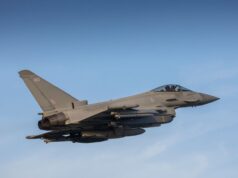NATO has confirmed that Italian Eurofighters based in Estonia and Hungarian Gripens operating from Lithuania scrambled this week to monitor Russian aircraft flying close to allied airspace.
According to NATO Air Command, “This week Italian Eurofighters based in Estonia and the Hungarian Gripens located in Lithuania scrambled to monitor Russian aircraft flying close to NATO airspace. NATO’s air policing assets in Estonia, Latvia and Lithuania remain steadfast as they continue to safeguard the integrity of NATO airspace from any potential threat.”
The intercepts form part of NATO’s Baltic Air Policing mission, which has operated continuously since 2004 to protect the airspace of Estonia, Latvia and Lithuania, all of which lack their own fighter aircraft.
Such scrambles are routine but reflect the persistent tempo of Russian military aviation activity near NATO borders. The alliance regularly identifies, tracks and intercepts Russian aircraft that fail to file flight plans or maintain radio contact while flying near allied airspace.
Operation Eastern Sentry, launched on 12 September 2025, was created in response to a Russian drone incursion into Polish territory that led Warsaw to invoke Article 4 of the NATO Treaty.
The operation brings together forces from Denmark, France, Germany, Italy and the United Kingdom to protect NATO’s eastern flank. It established a unified approach to air and missile defence along the alliance’s borders, replacing the previous system in which individual nations handled aerial threats independently.
The background to Eastern Sentry traces back to earlier efforts such as Baltic Sentry, launched in January 2025 to reinforce NATO’s military presence in the Baltic Sea. Poland’s Prime Minister Donald Tusk described the September incursion as bringing the country “the closest to an armed conflict since the Second World War.” In announcing the new mission, NATO Secretary General Mark Rutte said that “Russia’s recklessness in the air along our eastern flank is increasing in frequency. Whether intentional or not, it is dangerous and unacceptable.”
Rutte added that NATO’s deterrence measures now extend from the North Atlantic to the Black Sea, integrating air, land and maritime elements under a common command structure. He stated that the operation demonstrates the alliance’s readiness to “defend every inch of Allied territory” and its determination to confront any further violations of European airspace.














OMG no, this is shocking, every day we are having to Scramble and Intercept hostile bogies both at sea and in the air, how long can we survive this onslaught.
You talking about your Phal again Halffy?
It’s worse than that Jim,(Jim being the Captain and this being the song) there’s Klingons on the starboard side too
“Star trecking across the universe, always going backwards, still can’t find reverse”.
Beam me up Spock !
I’m deffo losing it, they said I would.
I fear that the half is becoming a quarter, based on this set of comments!
Concur…..maybe it really was the Phal?
My Google trawl around the word Phal has found nothing that could possibly be relevant, care to enlighten me?
“Phal”= Hot Curry, Hot curry leaves Exit Wounds and sometimes Klingons. Klingons are in Star Trek, so is Spock and Jim is Captain of the Enterprise.
Jim and Spock are Regular Posters.
“Star Trecking” was a song from the 80’s it contained the immortal words “There’s klingons on the starboard bow” and the next verse was “Well wipe them off Captain”.
Klingons are playing the part of Skidders which are a hazzard after consuming Hot Curry.
I just talk random shit. It flows naturally.
Ah, I remember your ‘discussion’ with DM yesterday.
Thank you, my day needed its seriousness taken down a notch!
You’re entirely welcome.
Its the sound one makes after…
No sound.
Silent but deadly 🔥💩🫢
Hi mate.
Just seen this, sorry.
I see the SME has already replied!
SME + LLY.
Hi DM, it’s all fine because this day was far too serious without some UKDJ banter.
Fart jokes is about the level my brain needs ATM!
Ah but no but hurting but,
A Phal fart is pretty serious.
Anyway It’s Friday and I’ve been way too serious lately.
Hi mate. A bit is okay, but.
I hope UKDJ is the premier UK Defence site for not only the articles, but the depth of knowledge and extra content subject matter added by the commentariat.
Half certainly adds depth!
Maybe this can be linked with DSTL Porton or DCBRE Winterbourne with Phal warfare.
Capsicum in concentrated quantities (especially Carolina Reapers) can cause serious pain, as proven in warfare and Police work.
I once rubbed a raw Reaper on an annoying neighbours car door handle and the result was indeed painfull (not for me though, I was larfing like a halfwit).
Seriously though, Nature has the most horific Toxins and deadly “comicals” I’m sure they are fully aware of that.
Yup, with NL for example the articles are longer and better written, but the comments are horrendously toxic (although there are some good SMEs) and consist largely of the same decade-long spats repeated over and over under each piece. I’m not a huge fan of the UKDJ article strategy of adding a tiny bit of context over the top of a press release but at least the comments are much more chilled out.
T Pedo, I looked in there a while back and the comments seemed very aggresive, lots of “One upmanship”. It’s not a site I’d like to comment on.
This site Is great for lots of different articles, not just Navy stuff and i’m really sorry I probably don’t fit the normal criteria but It’s just the way I am.
Life is way too short to be serious all the time.
I’d be happy to just talk shop if there was a comments section vote !
But I’m retired from all that and I’d get bored.
When I first saw the thumbnail I thought “are we bringing the Tornado F3s back into service”?
Anything for saving with this lot (and the last lot)!
Yes, understandable.
SU 24 Fencer, another swing wing.
I thought our F3s were awesome, personally.
Indeed, likewise. In their final configuration, with AMRAAM and ASRAAM, and the Radar upgrades, they were very good interceptors (not necessarily dogfighters, which is not what they were intended to be).
They were still pretty formiddable with semi-recessed Skyflash and Sidewinders.
Those upgrades to carry ALARM for op Telic were ace too. I wonder if the UK will get any anti-radiation missiles within the next decade…. I know a lot of people have said there is less need for them than in previous decades, but some countries seem to still see value in dedicated anti-radiation missiles.
There were suggestions some be kept for SEAD. Pity they were thrown on the scrapheap like so much else…courtesy of HMG.
This is abso terrible news, shock and horror. My day is ruined, I am going to my safe space.